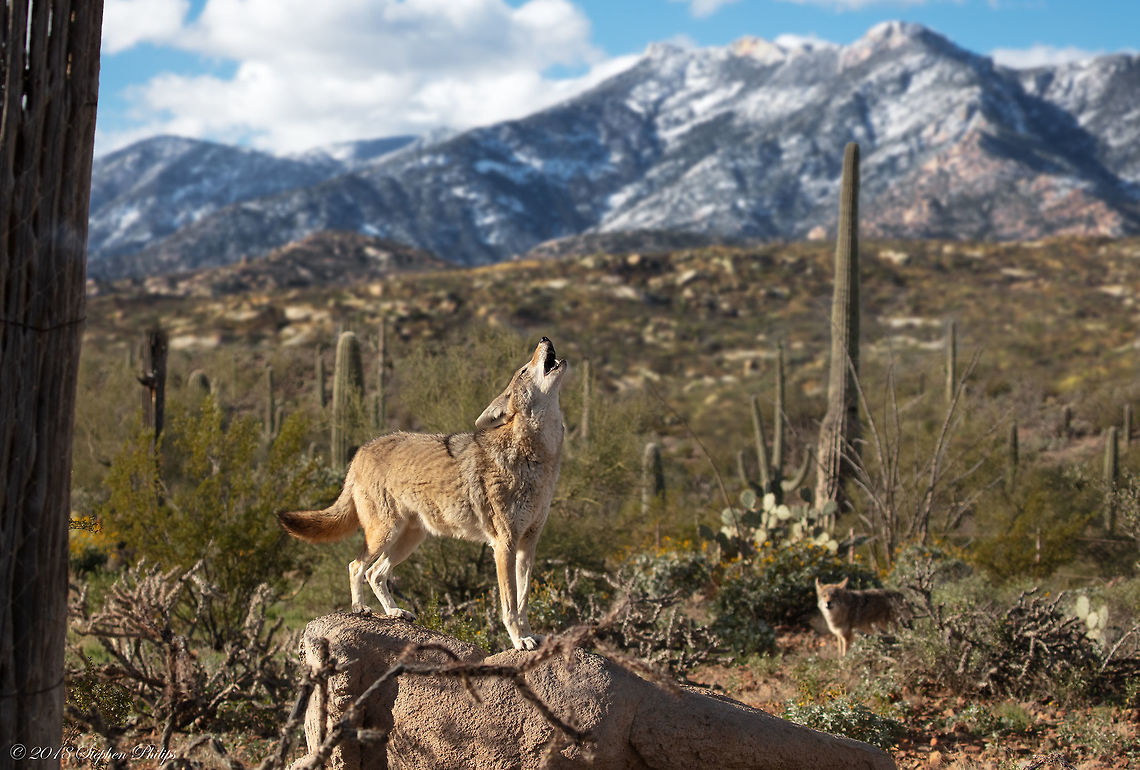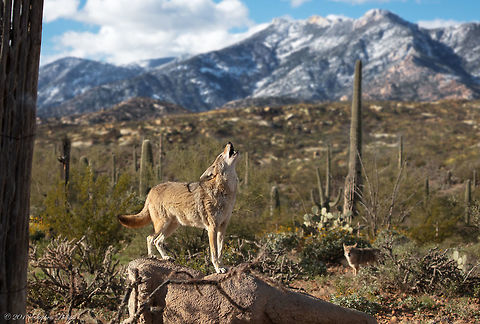 Promoted
Promoted
Howling Coyote
I hear the common calls of the coyote almost daily from my residence. This was the first time that I was able to witness their call in person and to be close enough to take a picture of this behavior. A second coyote is seen off in the background on the right who was also beginning to communicate.
Video from iPhone... sorry such poor quality but zoomed way in!
With a wide range that extends from Canada to Panama, Coyotes are a successful species that figure into the history, folklore, and present-day culture of the American West. Smaller than wolves and generally larger than dogs, coyotes boast coats that vary in color from gray to yellow. Most of Arizona's coyotes sport the telltale yellow desert coats. Mature coyotes may reach a weight of about fifty pounds and may grow as tall as forty inches. They are known for their considerable agility and speed-which may reach up to forty miles per hour.
Size: 40-46" in length, 24-36" tall
Weight: 19-25 lbs.
Diet: Primarily a carnivore, hunting and eating mostly small prey: rabbits, rodents, birds, amphibians, lizards, snakes, fish, crustaceans and insects and occasionally larger prey including elk, sheep and deer. Also carrion and some plant material: fruits and grasses.
Range: U.S. west of Appalachians including Alaska, south and west Canada and Central America
Habitat: Extremely diverse. Found in plains, mountains, desert, broken forests and tropics.
Life Span: 14-16 yrs.

The coyote, also known as the American jackal or the prairie wolf, is a species of canine found throughout North and Central America, ranging from Panama in the south, north through Mexico, the United States and Canada. It occurs as far north as Alaska and all but the northernmost portions of Canada.

comments (14)
Video post: Posted 6 years ago, modified 6 years ago
"What a stunning photo showing the alluring landscape of the American Southwest! This area of the United States has a beauty all its own that includes canyons, deserts, plateaus, and forests. It's home to a diverse variety of wildlife and plants such as bighorn sheep, desert tortoises, snakes, birds, reptiles, Joshua trees, cacti, tumbleweed, and wildflowers. And of course, the coyote (Canis latrans)!
Coyotes are adaptable animals that initially lived primarily in deserts and prairies, but they now roam most of North America. They will eat nearly anything, have keen vision, can run up to 40 miles per hour, and live in close family groups. They communicate with distinctive calls, which can develop into an eerily beautiful canine opus at night. Their numerous vocalizations include growls, yips, barks, howls, and whines that are used for different purposes. In fact, they have at least 11 unique vocalizations that can be categorized into three different groups: agonistic and alarm, greeting, and contact. For example, a coyote would use a long howl to let other members of the pack know where it is (contact). It would communicate with short barks to warn others of danger (alarm). Growls (agonistic) establish dominance, while yips welcome coyotes to the pack (greeting). Coyotes are described as the most vocal wild mammal in North America, an attribute that is demonstrated in this fantastic photo! {Spotted in Arizona, USA by JungleDragon user, Stephen Philips} #JungleDragon" Posted 6 years ago
Makes me want to find and record our wild dingoes although pure genetics are now scarce.
Thanks. Posted 6 years ago